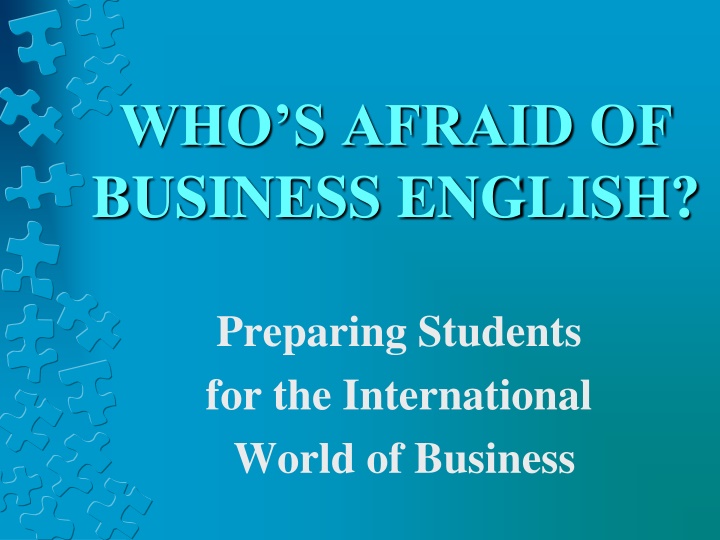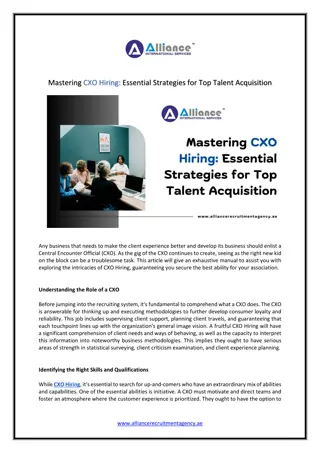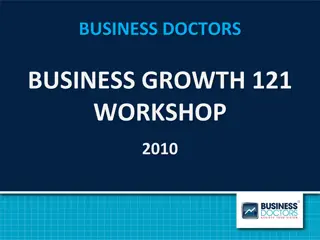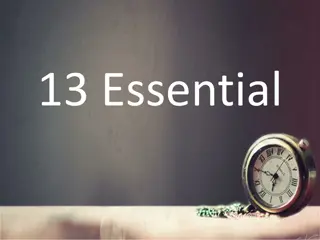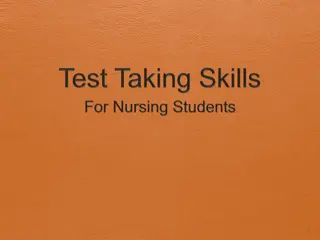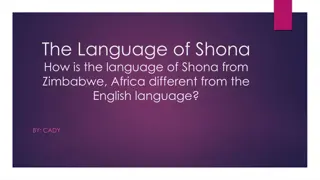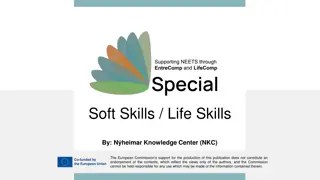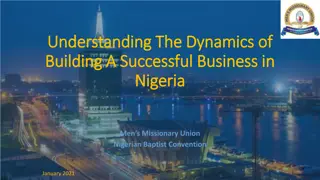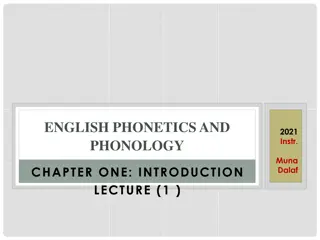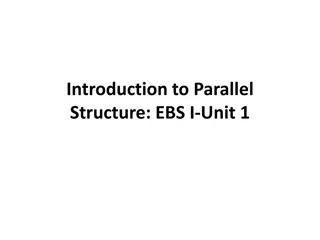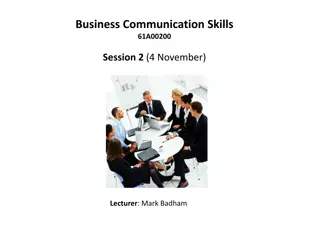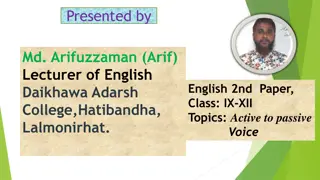Mastering Business English: Essential Skills and Strategies
Delve into the world of Business English to equip students with vital skills for success in the global business landscape. Discover why Business English is crucial, who benefits from it, what a curriculum should encompass, and how to effectively teach and develop listening and speaking abilities. Embrace the process of teaching Business English to prepare individuals for diverse career opportunities and enhanced communication proficiency.
Download Presentation

Please find below an Image/Link to download the presentation.
The content on the website is provided AS IS for your information and personal use only. It may not be sold, licensed, or shared on other websites without obtaining consent from the author.If you encounter any issues during the download, it is possible that the publisher has removed the file from their server.
You are allowed to download the files provided on this website for personal or commercial use, subject to the condition that they are used lawfully. All files are the property of their respective owners.
The content on the website is provided AS IS for your information and personal use only. It may not be sold, licensed, or shared on other websites without obtaining consent from the author.
E N D
Presentation Transcript
WHOS AFRAID OF BUSINESS ENGLISH? Preparing Students for the International World of Business
WHAT IS BUSINESS ENGLISH? A set of skills used to: Prepare people for careers Promote oral communication Develop professional writing Facilitate negotiating Enhance teamwork & networking
WHY TEACH BUSINESS ENGLISH? To meet today s challenges: Technology and industry Academia Global economics Travel Self-improvement
WHO NEEDS BUSINESS ENGLISH? Most employees in the following sectors: International trade & tourism Academia Industry and finance High-tech and more
WHAT SHOULD A CURRICULUM INCLUDE? The four basics, tailored specifically: LISTENING SPEAKING READING WRITING
PREPARING to TEACH View Business English as a PROCESS COURSE Begin easy progress to more advanced material Provide feedback Plan to hold 1-on-1 tutorials
DEVELOPING LISTENING Begin each lesson with pair-work. Distribute provocative sentences: 1. How true do you think the following statement is: You should work to live, not live to work ? 2. Is it better to marry someone of the same cultural background? Why? 3. Do you share goals and plans with others so that they will help you maintain your motivation and drive?
FOLLOW-UP After 5-10 minutes, during which you circulate and listen, ask several students to relate what their partners said.
ENCOURAGING SPEAKING 1. Begin by having students talk with a partner, then with a small group. 2. Next, have each get up before the class and talk for 30 seconds on short topics, such as news items: How does Re-Walk revolutionize movement for people who are partially paralyzed?
FACILITATING READING 1. Do not crowd the board; erase frequently. 2. Prepare worksheets using large, easy-to-read fonts, such as Tahoma, Comic Sans, and Ariel. 3. Leave space between lines. 4. Number items, for easy referral.
5. Assign a variety of texts for reading. 6. Check comprehension by holding group discussions. 7. Each group appoints a Speaker who reports back to the class
TEACHING WRITING Review the purpose and form of each type of writing: email letter, cover letter, agenda, request, apology, thank you, position paper, etc. Prepare TEMPLATES or samples for each writing assignment.
AGENDA SIMULATION Sample Agenda: Let's Promote Product X! Objective: Brainstorm a marketing campaign for our newest product Attendees: The Creative Department Date, Time and Duration: Monday, May 17th from 3:00 4:00 PM Location: Main Boardroom What to Bring: Your creative thinking caps and anything else that gives you creative inspiration Times, Agenda Items and Presenters: 3:00-3:15 Julie will remind us of key features of our product and the latest market research 3:15-3:50 Jim will lead the brainstorming session 3:50-4:00 Tanya and Nancy will summarize our progress
Group simulation: each group receives a challenge and has to create an Agenda, based on the sample. Group One: OLD ORCHARD A high quality apple juice made using organic fruit and traditional methods. It is sold at a premium price in restaurants and coffee shops. Market share and profit margins are declining. How can Old Orchard update its image and diversify into new markets? Group Two: CRUNCHY MORNING An exciting new range of breakfast cereals with unusual flavors: kiwi, grapefruit, passion fruit and pomegranate. How can Crunchy Morning capture a share of a saturated market?
PROFESSIONAL WRITING: The One-Pager Profile your company/product/service Distribute or display as a handout or leave behind at conferences, conventions, study days, etc. Zero in on your essence: your concept, your proposal or offering State your added value or benefits Use active voice, color and pictures Catch attention quickly Include contact information
HOW TO ASSESS Use RUBRICS 1. Prepare students: let them know the expectations of each assignment. 2. Decide what is the optimum level and give that the highest point value
3. Scale down, by adjusting the words you use, to deal with lower levels Example: a. HIGHEST LEVEL: Well- prepared and researched b. MODERATE LEVEL: Mostly well-prepared, with evidence of research c. LOWEST LEVEL: Little evidence of preparation or research
ASSESSING WRITTEN WORK Pay attention to all aspects you have taught. Decide the weight of each criterion See the sample below:
Criteria Excellent 91-100 Satisfactory 81-90 Apprentice 71-80 Argument and counter- argument are clear and supported throughout with well-selected evidence; clearly demonstrates wide knowledge of issue. Argument and counter- argument are usually clear and usually supported with evidence; some opposing arguments are unclear or not convincing; understanding of issue at adequate level. Argument and counter- argument are unclear or unsupported by evidence; opposing arguments are ignored or not rebutted; writer s understanding is unclear. Thesis & Argument 45% Introduction is interesting, body shows clear defense of position, and conclusion effectively summarizes position. Relevant & sufficient number of sources are cited and used to support argument. Clear, focused writing; sentences are grammatically correct and meaning is clear; word choice is appropriate; formal register; punctuation and spelling are nearly perfect. 3 or less errors. Intro/body/conclusion structure exists but some transition or organization problems may impede flow of paper. Some sources are not credible or relevant / OR not always used and cited to support arguments. Paper seems unorganized, OR paper does not flow well, OR lacking intro/body/conclusion. Insufficient, not credible, or irrelevant sources, OR not used to support arguments, OR no citation of sources. Organization & Sources 25% Essay is readable but includes some grammatical or mechanical errors; word choice is sometimes awkward or inappropriate; style not always formal. 4 7 errors. More than 8 writing errors; grammatical errors and other problems affect meaning; style sounds translated; tone is informal; use of slang. Writing Style & Grammar 30%
ASSESSING ORAL PRESENTATIONS Model through your teaching how students should give presentations. Tell them what you are doing, giving explanations where necessary. See the sample:
Excellent 91-100 Very Good 81-90 Need to Improve 71-80 Organization, Style, Content & Timing Presentation is clear, logical & organized. Clear introduction, body & conclusion. Evidence of effective research. Depth of material shows understanding. Timing is accurate. Presentation is generally clear & well organized: a few minor points may be confusing. Structure could use some reorganization. Research shown. For the most part, explanations are accurate & complete. Timing is nearly correct. Listener can follow presentation only with effort. Some arguments are lacking logic. Structure not always clear. Level is not always appropriate, & may be too simple or too complex. Much of information is read. Lacking evidence of academic references. Too long or too short. Lack of professional preparation. Font too small. Busy background that makes text difficult to read. Too much or too little information. Irrelevant material included. 45% ___ Power Point Slides Prepared in professional manner. Clear font. Right amount of information. Pictures, diagrams, colors & background clear. Mostly professional. Appropriate information. Most material, fonts, pictures, & backgrounds are clear. 10% ___ Grammar & Word Choice Sentences are complete & grammatical. Vocabulary is formal, sophisticated & precise. Parallelism in lists. No spelling errors. Sentences are mostly complete & grammatical. Level of vocabulary is usually correct; most words used correctly. Mostly parallel lists. Some spelling errors. Some grammatical errors and/or use of slang. Some incomplete or run-on sentences. Vocabulary may be limited or inaccurate. Lack of parallelism in lists. Frequent spelling errors. Inappropriate dress for the occasion. Lacking confidence. Nervousness obvious (pacing, throat-clearing, etc.) Difficult to understand words and/or sentences due to mispronunciation and/or heavy accent. Voice level uneven. Little or no eye contact. 15% ___ Personal Appearance, Body Language & Clarity of Speech Completely appropriate dress for the occasion. Poised & confident. No unnecessary movements. Standard pronunciation of words & good flow of sentences. Speaker can be heard by all. Eye contact at all times. Generally appropriate dress for the occasion. Mostly poised & prepared. One or two nervous gestures. Mostly accurate pronunciation and adequate flow of sentences. Voice level mostly even. Slight accent. Eye contact most of the time. 30% ___
UTILIZE THE MEDIA LISTENING: YouTube, Macmillan, TED and BBC for video clips and texts of authentic conversations SPEAKING: Use authentic conversations for practice e.g. telephoning back-to-back
Caller (Computech) Called Person (Intech) Intech, good morning. Greeting. Introduce yourself. Ask caller to spell name. Confirm/correct. Offer to help. Ask for an appointment with Mr. Townsend. Ask what it s about. Explain that you want to discuss the shipping of goods from Tokyo to Ashdod Port. Acknowledge ask when would be a good time. Suggest next week. Reject Mr. Townsend is away. Suggest beginning of next month. Agree. Suggest Monday the 3rd. Reject on Monday, Mr. Townsend is busy all day. Suggest Tuesday the 4th. Agree. Suggest 10:00 a.m. Agree ask for an email to confirm. Offer to book a hotel. Agree to email. Hotel booking is not necessary. Signal you are finished. End call / thanks / remind caller of email, etc. End call.
READING: texts from Time, MIT Technology Review, BBC WRITING: provide samples, templates and outlines from owl.purdue, Oxford UP, Macmillan
Dear Janet: Here is my market report; I know it is a bit late, and I apologize. I hope you notice that I am using many of the terms that I heard at the recent Trade Conference in Tokyo they are the latest trend in the field. I didn t see any good reason to include the data that I usually submit: I think everyone on the team is aware of it. If you have any comments or suggestions, let me know. Regards, Jackson Mahler
WHAT ABOUT GRAMMAR? Consider major issues: Tenses: active, passive & MODALS Punctuation & capital letters Sentence and paragraph structure Parallelism, run-ons, prepositions DEVOTE TIME EACH LESSON TO GRAMMAR
EXERCISE, BRIEFLY Nothing is more embarassing than making a writing mistake? Of course, we all think its funny when we spot a mispelled word in magazine ads or on billboards. If one of your employee s are making the the mistakes, it can be disasterous. And if you have a typo in a memoo to the boss; how do you think they will view your professionalism? These kind of mistakes can be prevented, irregardless of the persons job title. The people that make the mistakes can seriously effect how other s view you re company.
V.A.T. Cultural know-how: Make students aware of cultural differences, using English as an intrinsic part of communication in multinational settings Use Kiss, Bow, and Shake Hands as the text for this unit
UNIT ON MULTICULTURAL BUSINESS PRACTICES CONSIDER: 1. Welcoming and introductions 2. Settling in and using small talk 3. Planning for the visit and setting preliminaries 4. Beginning discussions & negotiations 5. Following-up
CHOOSE GROUPS & COUNTRIES 1. Allow 30-40 minutes for organization. The rest must be done out of class. 2. Email Kiss, Bow, or Shake Hands 3. Students prepare an 8-10 minute oral presentation dealing with key issues (using PowerPoint)
BEGINNINGS Grow and develop with your students. Ask for feedback after every activity. Innovate. Seek out new materials. At the end of the course, ask them: what should I KEEP, DISCARD, and CHANGE. Then DO exactly that!
TRUST YOUR STUDENTS & TRUST YOURSELF
CONTACT ME! Judy Siegel Henn, Ph.D. Division of Humanities The Technion henn_judy@yahoo.com 052-8714283
REFERENCES English as a Lingua Franca in International Business Contexts. Editorial. English for Specific Purposes 24 (2005):367-80. http://pbp.typepad.com/nobull/2010/01/how -many-writing-mistakes-can-you-find.html Morrison, Terri and Wayne A. Conaway (1995, 2006). Kiss, Bow, or Shake Hands: The Bestselling Guide to Doing Business in More Than 60 Countries. Avon, MA: Adams Media.
